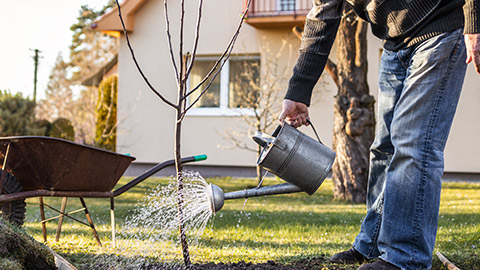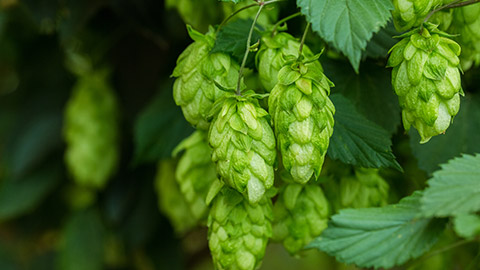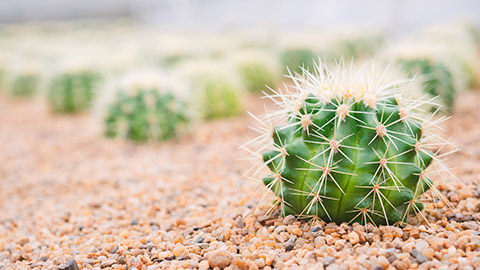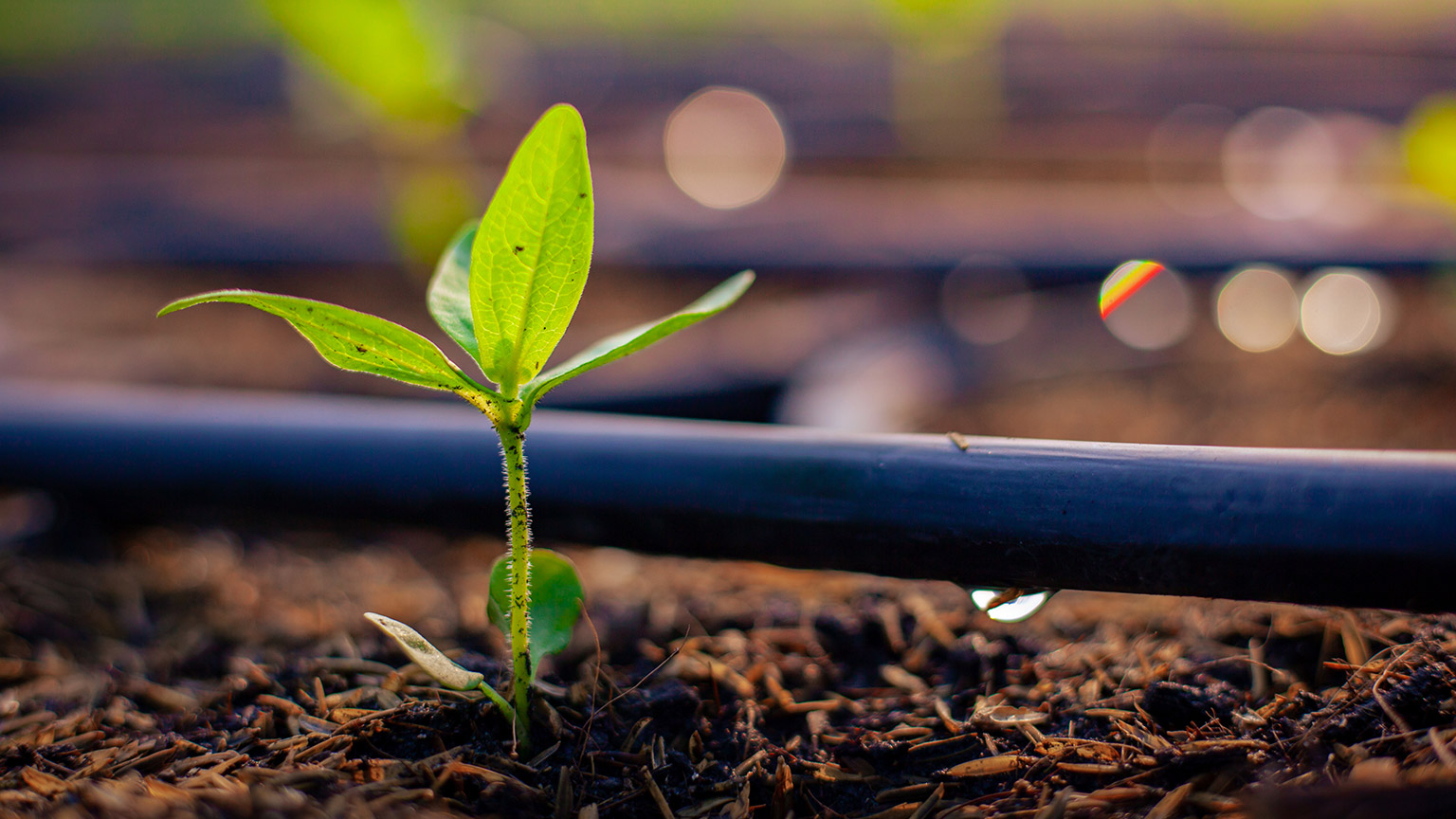Do you recognise the system being used to water this plant? The pipe and water drop strongly suggest this is a drip system.
Vast quantities of water is one of the key things that makes our planet different from our neighbours in the solar system.
US Department of Commerce and National Oceanic, 2013
The importance of water
Water is needed for plants and animals to live.

USGS.govWater accounts for roughly 55-78% of the human body.
With that in mind, it is perhaps no wonder that the word for freshwater in te reo Māori is wai māori; freshwater is treated with reverence. Some would even say that “water is life".
Watch this video if you are interested to learn more about the kaupapa Māori of water in traditional horticultural practices.
Soil water management
In this section, we'll learn how to make sure that your soil has the right amount of water – not too little, not too much.
Challenge yourself to identify the activities involved with soil water management below. Don't worry if you don't have a handle on it yet, we're just getting started. Use the icons below the activity to answer all three questions.
Soil water management involves understanding how much water specific plants need, correctly using irrigation systems, applying mulch, and installing and maintaining drainage systems.
Proper soil water management can also:
- help conserve water resources
- reduce erosion
- prevent the leaching of nutrients and chemicals from the soil.
It is an essential component of sustainable growing and is critical for the success of horticultural crops.

One way to think of soil water is as a bank account; specifically the kind of account you use to pay your bills from. Money comes in and then some goes out again. Rainfall and irrigation are our two main sources of “income,” while runoff, percolation, and evapotranspiration are our main “expenses.”
| Percolation | When water drains down through the root zone and into deeper layers of the soil. |
| Evapotranspiration (ET) | The total amount of water lost from the soil through evaporation and from the leaves of plants due to transpiration. |
| Soil water budget | The balance between the two that the grower must manage effectively. This will guide how much and when to irrigate. |
We just mentioned transpiration again. Complete this short activity to remind yourself what it is before continuing:
The following video by GeogKilv, provides a good overview of a soil water budget for a full year. The video is from the UK, so the graph shows the months as they relate to northern-hemisphere seasons. Just ignore the months and listen to his description of what happens during each season.
The video shows how a soil water budget works for a large area, but the same principles apply to a field growing crops, or garden. We’ll come back to soil water budgets later in this module. First, we need to understand this budget's different variables (income and expense categories).

To understand a soil budget's different variables, we would need to examine the local:
- environment
- soil
- plants.
Environmental factors
The environment can affect both how much water “income” we have and how much water we lose as “expenses.”
For instance, more precipitation (rain, snow, sleet, hail) fell on the West Coast region in 2020 than on the entire North Island Te Ika a Maui that same year!
The North Island and South Island had noticeably different seasonal patterns in precipitation, with precipitation highest in the September quarter (July–September) for the North Island and in the December quarter (October–December) for the South Island
Environmental-economic accounts: Water physical stocks, year ended June 1995–2020
You have the information you need to answer the following two single-answer questions.

Consider the knowledge you have already learned about ET rates, transpiration, and photosynthesis, and see if you can come up with a list of the effects additional heat from the sun has on plants before expanding the label to check your answer below.
- It causes water to evaporate more readily.
- It helps plants to photosynthesise more and respire more, leading to greater transpiration.
- It leads to higher temperatures year-round, which causes the growing season to be longer.
A study of two cities: Nelson vs. Hokitika
Let’s compare the average temperatures, rainfall and sunshine of Hokitika in the West Coast region, and Nelson, some 250km north, in the following table.
| Hokitika | Nelson | |
|---|---|---|
| Annual average high temp | 15.7 °C | 17.5 °C |
| Annual average low temp | 7.7 °C | 7.9 °C |
| Annual average rainfall | 2,850 mm | 960 mm |
| Annual average sunshine hours | 1,877 hrs | 2,472 hrs |
Historical annual average temperatures, rainfall, and sunshine hours for Hokitika and Nelson.
Sources: Wikipedia contributors 1; Wikipedia contributors 2.
After studying the information above, put your understanding to the test with the following activity:
Evapotranspiration
In 2020, one-third (33%) of Nelson’s precipitation was “lost” back to the atmosphere in the form of evapotranspiration. By lost we mean it didn’t stay in the soil (our “bank account”).
For Hokitika, ET for 2020 was only 8% of the total precipitation.
| Average daily ET rate for a reference crop (ET0) in mm | ||
|---|---|---|
| Month | Hokitika | Nelson |
| January | 4.7 | 5.8 |
| February | 3.2 | 3.5 |
| March | 3.2 | 3.4 |
| April | 1.6 | 2.0 |
| May | 0.7 | 1.1 |
| June | 0.5 | 0.6 |
| July | 0.6 | 0.8 |
| August | 1.0 | 1.1 |
| September | 1.6 | 1.9 |
| October | 2.6 | 3.4 |
| November | 3.4 | 4.5 |
| December | 4.2 | 5.1 |
Average daily evapotranspiration rates for a reference crop, by month for 2022 in Hokitika and Nelson.
The data above was sourced from NIWA Clifo – The National Climate Database — the web system that provides access to New Zealand's National Climate Database. It would be good to bookmark it for your resources.

Wind
When wind speed increases, it dries out the soil more quickly. It also causes transpiration to increase by moving water vapour away from the leaves, creating a greater difference between the amount of water vapour inside and outside the leaves.
Humidity
When humidity is high, the rate of transpiration decreases because there is a lot of water vapour around the leaves.
Run-off and groundwater recharge
Water is also lost from the soil by running off the soil surface or moving through the soil into waterways and out to sea, or down deep into the soil and bedrock where it recharges underground lakes called aquifers.
Soil characteristics
Several characteristics of soil influence its water-holding capacity, including:
- Texture: Sandy soils have larger particles and tend to drain water more quickly, while clay soils have smaller particles and retain water for longer periods. Soils with a balanced texture, known as loam soils, generally have good water holding capacity.
- Additionally, because sandy soils have generally high percolation rates, water applied flows almost straight down. In clay soils, low rates of percolation mean that as more water is applied, the water high up in the soil spreads sideways due to the weight of the water being applied on top. Accordingly it is said that clay soils spread water, while sandy soils let it drop.
- Structure: Well-structured soils with good aggregation have more pore spaces, allowing for better water infiltration and retention. Soils with poor structure, such as compacted soils, have reduced pore spaces and limited water holding capacity.
- Porosity: Porosity – how much open space there is in the soil – is primarily a function of soil texture and structure, but it can also be affected by cultivation practices. For instance, soils that are ploughed or tilled regularly tend to be highly porous immediately after cultivation but compact over time. Soils that aren’t cultivated regularly and are covered by crops are generally more porous overall. This is due to the fact that plants put down roots which break up the soil and, by not disturbing the soil biology, worms and microorganisms help form well-structured soil.
- Organic matter content: Organic matter acts like a sponge, absorbing and retaining water. Soils rich in organic matter have improved water retention capabilities, as organic particles create more pore spaces.
- Compaction: Compacted soils have reduced water-holding capacity because water cannot penetrate easily and tends to run off the surface. Compaction can be caused by heavy machinery, foot traffic, or natural processes like heavy rainfall.
- Depth: Deep soils can store more water compared to shallow soils due to a greater volume of soil available for water storage.
- Slope and topography: Steep slopes tend to have faster water drainage, reducing water holding capacity, while flatter slopes allow for more water infiltration and retention.

Let's take a moment and ensure you are confident about how soil characteristics influence how much water it can hold.

Plant characteristics
Several plant characteristics play a role in determining water uptake. Let's start with an activity that describes a single plant part that plays a significant role in water soil management.
In addition to the roots of the plant, the following characteristics also impact water soil management:
- Stomatal regulation: Stomata are small openings on the surface of leaves that control the exchange of gases and water vapour. Plants can regulate the opening and closing of stomata to minimise water loss through transpiration. When water availability is limited, plants may close their stomata partially or completely to conserve water, which affects water uptake.
- Leaf area and transpiration rate: The leaf area of a plant affects the rate of transpiration. Higher leaf area generally leads to higher transpiration rates, resulting in increased water uptake to compensate for the lost water.
- Plant physiology: The physiological traits of a plant, such as its water use efficiency and ability to tolerate water stress, can influence water uptake. Some plants have adaptations that allow them to thrive in water-limited environments, such as succulent leaves that store water or mechanisms to reduce water loss. Likewise, some monocots, including some grasses – referred to as warm-season grasses – use a more efficient photosynthetic pathway called C4 photosynthesis. This pathway allows them to better utilise carbon dioxide and reduce water loss during photosynthesis.
